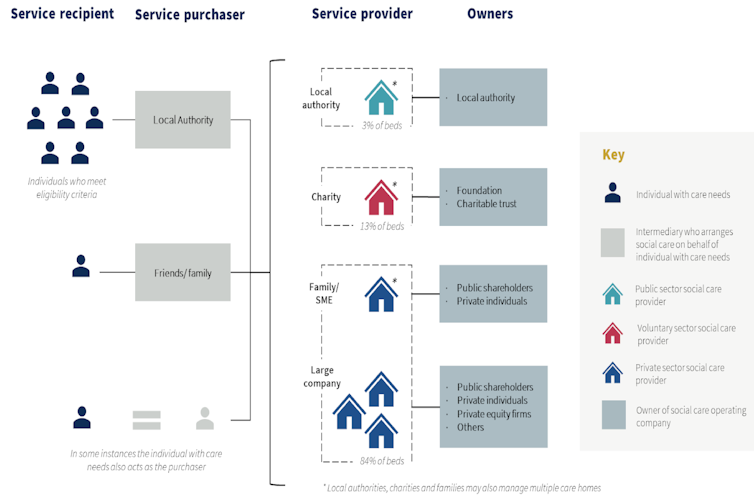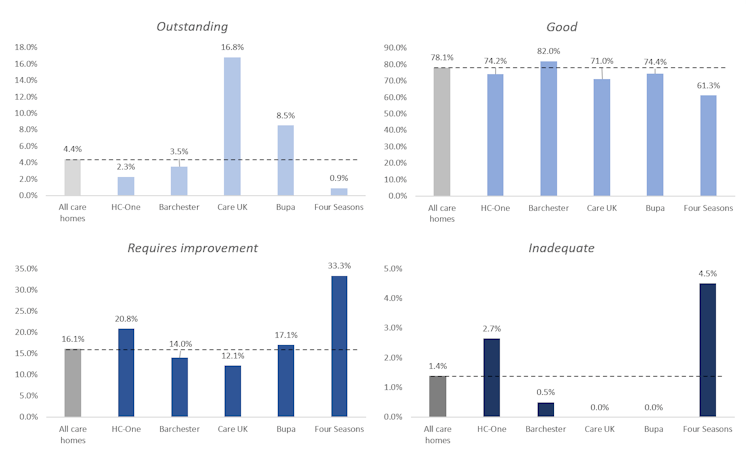Care homes: why investment firms can be bad owners
The UK government is about to reform social care, but the focus is likely to be on funding, not the companies that are allowed to have a stake in the sector, Christine Corlet Walker writes, summarising her recent work together with Tim Jackson and Angela Druckman on ‘Careless Finance. This blog first appeared on The Conversation.

The ailing social care system in England is due to be reformed as part of plans being announced in the Queen’s Speech in May. The most prominent issue is long-term funding, with the UK prime minister, Boris Johnson, recently talking up the need for a “ten-year plan” to fix the sector.
But while reform is good news, the question of how to fund the sector is not the only one that needs to be asked. There are fundamental questions about who is providing (and profiting from) social care, and how this affects quality and economic stability in the sector.
The care market
Like many European countries, UK adult social care is a quasi market. It is provided by a mix of private, voluntary and public players. Private companies and financial investment groups got involved after the marketised structure emerged in the 1990s.
In 2019, private players provided 84% of care home beds. Local authorities and the National Health Service cover the cost of about half of these services, on a means-tested basis, while the clients and their families pay the rest (see graphic below – click to make it bigger).

The sector has many small providers. Barely one-third of beds are in the hands of the top 25 companies, and the top five control about 11% of the market. Nonetheless, the five leading operators – HC-One, Four Seasons, Care UK, Barchester and Bupa – still provide some 50,000 beds between them.
Of the five, HC-One and Care UK are currently owned by private equity firms. Four Seasons also had a private equity owner (Terra Firma) until it went into administration in 2019, and was acquired by US-based hedge fund H/2 Capital. Barchester is majority-owned by three Irish billionaires, Dermot Desmond, John Magnier and JP McManus as part of a group of 50 investors. Bupa is a not-for-profit private company, meaning it reinvests all profits back into the business.
Top five care companies

There have been many concerns about financial investment outfits being involved in care provision, and whether this has negatively affected economic stability and the quality of care. As well as the Four Seasons failure, private equity was at the centre of the collapse of then leading UK provider Southern Cross in 2011.
Investment firms have become notorious in many sectors for taking over underperforming companies and loading them with debt, before using short-term strategies to maximise their profits for a quick return. With private equity, there is the additional issue that they are not listed on the stock market and therefore less regulated than listed investors in relation to financial disclosure requirements.
But what does the data say about how these financial entities affect the care sector? Our new Careless Finance report at international research network the Centre for the Understanding of Sustainable Prosperity aimed to find out.
What we know
The evidence that for-profit care homes deliver worse-quality care than voluntary and public sector operators is compelling. From Taiwan and Australia to the UK and the US, many studies have found that for-profit operators have on average fewer staff hours per resident and worse indicators for quality of service.
When it comes to the specific impact of investment companies, the results are more mixed. The evidence tends to focus on private equity ownership, is highly US-centric, and looks primarily at nursing homes as opposed to residential care. Many studies do indicate that private equity can reduce certain measures of quality of care, but others find no impact at all.

How can this difference in findings be explained? Nursing home quality and governance experts Aline Bos and Charlene Harrington hit the nail on the head when they point out that private equity ownership per se is not the problem. Rather, it is the particular management strategies – such as reducing the number of registered nurses or time spent with clients – that can negatively affect quality. Some studies might therefore be looking at the wrong link in the chain.
Several management strategies and financial practices associated with investment companies can affect quality of care and undermine care companies’ long-term financial stability. For example, recent US research indicates that leveraged buyouts – where an investment firm buys a company using a large proportion of debt – “increase the probability of bankruptcy for the target firm by approximately 18%”.
For companies that provide foundational welfare services to some of the most vulnerable in society, this is a worrying prospect.
All five of the UK’s largest care home chains exhibit signs of financial engineering. Three have seen leveraged buyouts, while four have complex group structures, including related companies in tax havens, intra-group loans and sale and leaseback arrangements (where a care home property is sold off and rented back to the social care company).
Top five operators and financial arrangements
Three out of five of these operators have more care homes than average in either the “requires improvement” or “inadequate” quality ratings categories, as shown below (though one of them, Bupa, also has a disproportionate number of “outstanding” homes) . This is based on the most recent inspections by the Care Quality Commission regulator, which were conducted in the past year for all homes in the bottom two categories.
The below-average performances by some of these operators could be for many reasons. The companies might be buying lower-quality care homes to begin with because they see a greater opportunity for value growth. Equally, the average number of beds in these chains could well be higher – something known to be associated with lower-quality care.
Care homes in each quality category, by operator

Because of the complexity of the factors that determine quality outcomes, careful research is required to identify the role of each management strategy and financial practice. But given the relationships identified in the US, this certainly calls for a closer look in the UK.
The large proportion of public funding going to these companies makes this a clear issue of public accountability. With social-care reform apparently imminent, the government should surely get a better handle on the scope and depth of these challenges. Proposals to limit potentially damaging aspects of financialisation could then be brought forward, such as enhanced financial transparency, restrictions on companies that use tax havens, and limiting high-risk financing techniques.
To make proposals focused solely on long-term funding – as vital as that may be – would be a missed opportunity. It would risk leaving social care on a path of continued economic instability and crisis.
The Conversation invited the top five operators to respond to the findings in this article. All replies can be accessed via theconversation.com.



